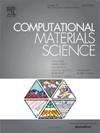Specific surface area (SSA) of perovskites with uncertainty estimation approach
IF 3.1
3区 材料科学
Q2 MATERIALS SCIENCE, MULTIDISCIPLINARY
引用次数: 0
Abstract
In recent years, the rapid development of computer technology and the Internet has enabled faster and more convenient data acquisition. Using big data and machine learning (ML) to accelerate the development of new materials is crucial. This study provides insight into the application of ML in predicting the specific surface area (SSA) of ABO3-type perovskite. In this article, we initially introduce the basic concepts of ML, its general workflow in materials research, and the specific algorithms used. We further discuss the structural features of ABO3-type perovskites and their development trends in photocatalytic applications. The prediction of SSA is vital for the application and performance optimization of perovskites, and ML provides an efficient and accurate means of prediction. In the modeling process, we collected experimental data on 50 ABO3-type perovskites from published literature and feature-engineered them in various ways to obtain three different datasets. By screening the features through principal component analysis (PCA) and Genetic Algorithm (GA), we found that GA is superior to the Random Forest (RF) model. At the same time, PCA is more suitable for the Support Vector Regression (SVR) model. The test results showed that the RF model has a prediction accuracy of 0.832, while the SVR model has a prediction accuracy of 0.808, and both methods exhibited high prediction accuracy. In addition, the leave-one-out cross-validation results further confirmed the robustness of both models. Finally, we conducted an in-depth analysis of the importance of features. The results showed that the calcination temperature (CT) and calcination time (AH) are the most critical features, which are positively and negatively correlated with the SSA of perovskite oxides, respectively. This provides valuable reference information for the design and optimization of perovskite materials. Overall, this study successfully predicted the SSA of ABO3-type perovskites using an ML method, which provides a new and effective tool for researching and applying perovskite materials.
求助全文
约1分钟内获得全文
求助全文
来源期刊

Computational Materials Science
工程技术-材料科学:综合
CiteScore
6.50
自引率
6.10%
发文量
665
审稿时长
26 days
期刊介绍:
The goal of Computational Materials Science is to report on results that provide new or unique insights into, or significantly expand our understanding of, the properties of materials or phenomena associated with their design, synthesis, processing, characterization, and utilization. To be relevant to the journal, the results should be applied or applicable to specific material systems that are discussed within the submission.
 求助内容:
求助内容: 应助结果提醒方式:
应助结果提醒方式:


